Articles
- Page Path
- HOME > Restor Dent Endod > Volume 34(1); 2009 > Article
- Original Article Stress distribution for NiTi files of triangular based and rectangular based cross-sections using 3-dimensional finite element analysis
- Hyun-Ju Kim1, Chan-Joo Lee2, Byung-Min Kim2, Jeong-Kil Park1, Bock Hur1, Hyeon-Cheol Kim1
-
2009;34(1):-7.
DOI: https://doi.org/10.5395/JKACD.2009.34.1.001
Published online: January 31, 2009
1Department of Conservative Dentistry, School of Dentistry, Pusan National University, Busan, Korea.
2Division of Precision Manufacturing Systems, Pusan National University, Busan, Korea.
- Corresponding Author: Hyeon-Cheol Kim. Department of Conservative Dentistry, School of Dentistry, Pusan National University, 1-10 Ami-Dong, Seo-Gu, Busan, Korea. Tel: 82-51-240-7978, golddent@pusan.ac.kr
• Received: June 13, 2008 • Revised: July 3, 2008 • Accepted: July 8, 2008
Copyright © 2009 The Korean Academy of Conservative Dentistry
- 1,141 Views
- 6 Download
- 3 Crossref
Tables & Figures
REFERENCES
Citations
Citations to this article as recorded by 

- Ex-Vivo Comparison of Torsional Stress on Nickel–Titanium Instruments Activated by Continuous Rotation or Adaptive Motion
Joo Yeong Lee, Sang Won Kwak, Jung-Hong Ha, Hyeon-Cheol Kim
Materials.2020; 13(8): 1900. CrossRef - Autogenous teeth used for bone grafting: a comparison with traditional grafting materials
Young-Kyun Kim, Su-Gwan Kim, Pil-Young Yun, In-Sung Yeo, Seung-Chan Jin, Ji-Su Oh, Heung-Joong Kim, Sun-Kyoung Yu, Sook-Young Lee, Jae-Sung Kim, In-Woong Um, Mi-Ae Jeong, Gyung-Wook Kim
Oral Surgery, Oral Medicine, Oral Pathology and Oral Radiology.2014; 117(1): e39. CrossRef - Analysis of crystalline structure of autogenous tooth bone graft material: X-Ray diffraction analysis
Gyung-Wook Kim, In-Sung Yeo, Su-Gwan Kim, In-Woong Um, Young-Kyun Kim
Journal of the Korean Association of Oral and Maxillofacial Surgeons.2011; 37(3): 225. CrossRef
Stress distribution for NiTi files of triangular based and rectangular based cross-sections using 3-dimensional finite element analysis
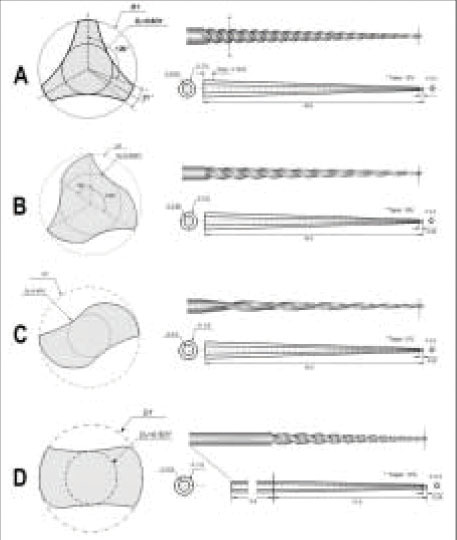
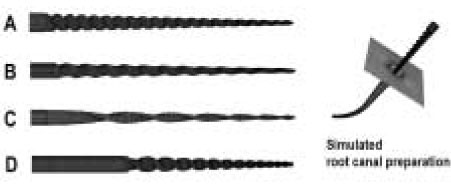
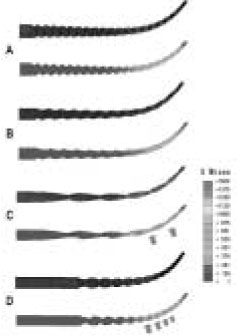
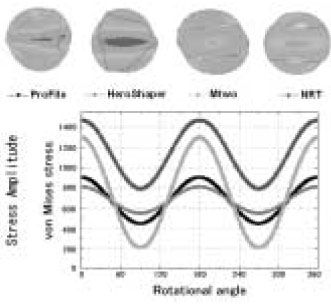
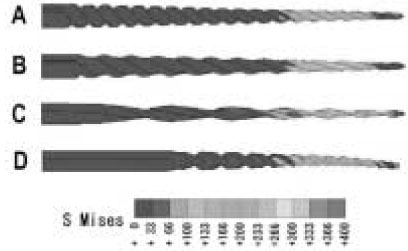
Figure 1
Cross-sectional and longitudinal geometries of four NiTi files; (A) ProFile .06 / #30, (B) HeroShaper .06 / #30, (C) Mtwo .05 / #30, (D) NRT .06 / #30.
Figure 2
Final FE models of four NiTi files and simulated root canal; (A) ProFile .06 / #30, (B) HeroShaper .06 / #30, (C) Mtwo .05 / #30, (D) NRT .06 / #30.
Figure 3
External surface and internal sectional view of stress distribution during simulated root canal shaping; (A) ProFile .06 / #30, (B) HeroShaper .06 / #30, (C) Mtwo .05 / #30, (D) NRT .06 / #30.
Figure 4
The stress changing cycles of the nodes (red point) where maximal von Mises stresses were concentrated.
Figure 5
The residual stress distribution after elastic recovery of withdrawn file (A; ProFile 326 MPa, B; HeroShaper 352 MPa, C; Mtwo 448 MPa, D; NRT 571 MPa).
Figure 1
Figure 2
Figure 3
Figure 4
Figure 5
Stress distribution for NiTi files of triangular based and rectangular based cross-sections using 3-dimensional finite element analysis

 KACD
KACD





 ePub Link
ePub Link Cite
Cite

